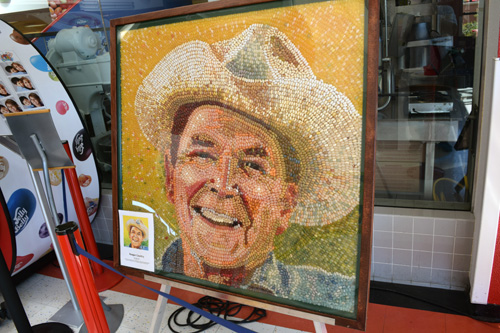
By Donald H. Harrison

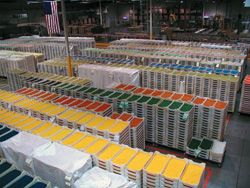
FAIRFIELD, California – On a day that my son David and his wife Cathy had to go to their work, and our grandchildren were in schools, my wife Nancy and I arranged to meet former Escondido residents Gerry and Judy Burstain, and Judy’s mother, Eleanor Lieb, halfway between the Sacramento area, where they now live, and the San Francisco Bay area where my son and family now reside.
A map told us that a halfway place was the town of Fairfield on the Interstate 80. A brief Internet search told us that Fairfield was the home of the Jelly Belly factory. I remembered from my days covering Sacramento as a political reporter that Gov. Ronald Reagan – who, of course, later became President Reagan—had a fondness for jelly beans. He used to have jars of them in his reception area in the state Capitol, and, later, when he became President, he had them in the Oval Office and in various White House conference rooms. Of all the jelly beans one might find in the world, Reagan developed a marked preference for those called “Jelly Belly” beans.
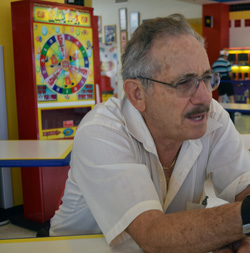
So we agreed our rendezvous would be at the Jelly Belly factory, where we could take a tour, and then have lunch while renewing old acquaintances. While living in Escondido, Gerry had been quite active at Congregation Ner Tamid, serving as president of that Conservative synagogue and often as a Torah reader as well. Being a native-born Israeli, reading the Hebrew of the Torah was as easy, maybe easier, as it is for you to read this column. Gerry also served as a president of the north county division of the San Diego World Affairs Council. He has become similarly involved in his new community of Lincoln, California, where there is an extensive housing development for senior citizens.
Meeting halfway in Fairfield was hardly our invention. I learned from Mimi Pollack, who writes for San Diego Jewish World, that when she was a student at UC Berkeley, one of her sisters was a student at UC Davis. They decided to share an apartment in Fairfield, from which they could commute approximately the same distance to their respective campuses.
At the Jelly Belly factory, I was delighted to read that Jelly Belly beans are OU kosher certified because when I hear the word “jelly,” I have learned to become a little suspicious. “Jellies” often are made with gelatin, a substance used in many foods—especially candies and marshmallows. Gelatin is made by rendering collagen from various barnyard animals, including pigs. So, it’s a good bet that if a product has gelatin in it, it may be treif. This year of 2015 the Orthodox Union (OU) named Jelly Belly its company of the year.
Jelly Belly beans don’t have any gelatin in them. This company’s candy-making process involves using such natural ingredients for the center of the candy (they make over 100 flavors) as coconuts; strawberry, banana and pear purées) and fruit concentrates along with sugar, corn syrup, modified food starch (from corn), flavors and colors. Slurries are poured into a shell, coated with flavors, polished, boxed and shipped. Candies that don’t quite meet Jelly Belly specifications—perhaps too big, or misshapen—are called “Belly Flops” and sold separately. They taste the same.
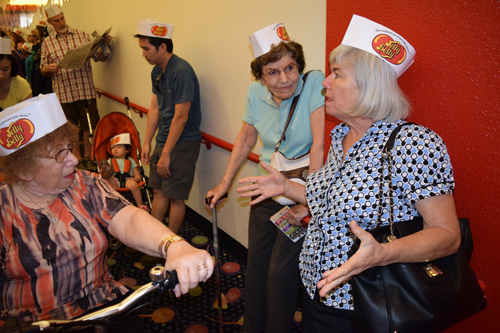
The tour of the factory is free. You are given a little paper hat, unless you happen to be wearing a regular hat, and then march around an upstairs perimeter from which you can look down through plastic at the processes below. A guide leads you from station to station, where after a brief introduction he or she activates a video which outlines the process that you are observing. Cameras, videotape recorders, and audio recorders all are banned from use on the tour. The production line photo of stacks of Jelly Belly candy accompanying this article was sent to me by Jelly Belly’s public relations department.
The company once known as Goelitz Confectionary Company brought out its first Jelly Belly beans in 1976, and as they gained in popularity, they became known to the former governor and Nancy Reagan, then living in the Los Angeles area. As he gained in popularity, so too did the Jelly Belly beans which became identified with him. After he was elected as President, Jelly Belly developed a blueberry candy so that gift packs could be made up in red, white and blue colors. Three and a half tons of the candy were shipped to Washington DC for the 1981 Inaugural balls.
With this kind of publicity, demand for Jelly Belly candies grew. Today, the candy company ships its candies to 77 countries around the world.
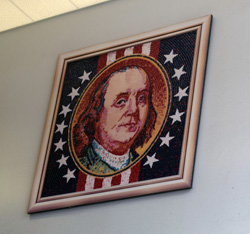
A new art form – Jelly Belly portraits – also became popular. Given that Jelly Belly beans are made in numerous colors, some artists like to use them as building materials for mosaics. Typically, an artist will first sketch out a drawing, and then paste the Jelly Belly beans onto the drawing to create an unusual textured effect. Of course, Ronald Reagan was one of the first subjects for Jelly Belly artists, but at the Jelly Belly factory we saw portraits of numerous other American political figures, particularly the Founding Fathers.
Following the tour, we were given a free gift pack of Jelly Belly beans. We could also go to a station offering free samples at which visitors could choose three Jelly Belly beans of any flavor. Twenty Five Jelly Belly candies, I learned, weigh one ounce. A single Jelly Belly is four calories. One could return to the free sample line again and again for little trios. Other kinds of candies including chocolates, gummies, and candy corn also were offered as samples, and, of course, the factory has a large outlet store where you can buy the candies at very competitive prices.
Next we went to the cheerfully decorated restaurant where, no, we were not required to satisfy our appetites with Jelly Belly beans. There was the normal assortment of hamburgers and sandwiches one might find at any amusement park. The sodas on tap were Coca-Cola products. The large restaurant is conveniently located near the terminus of the tour and close to the stores and sampling station.
*
Harrison is editor of San Diego Jewish World. He may be contacted via donald.harrison@sdjewishworld.com
Nice article!! 🙂 I also like the pictures. So funny that you included what I told you. I hate to admit it, but I love jelly beans in their bubble gum flavor! — Mimi Pollack, La Mesa, California